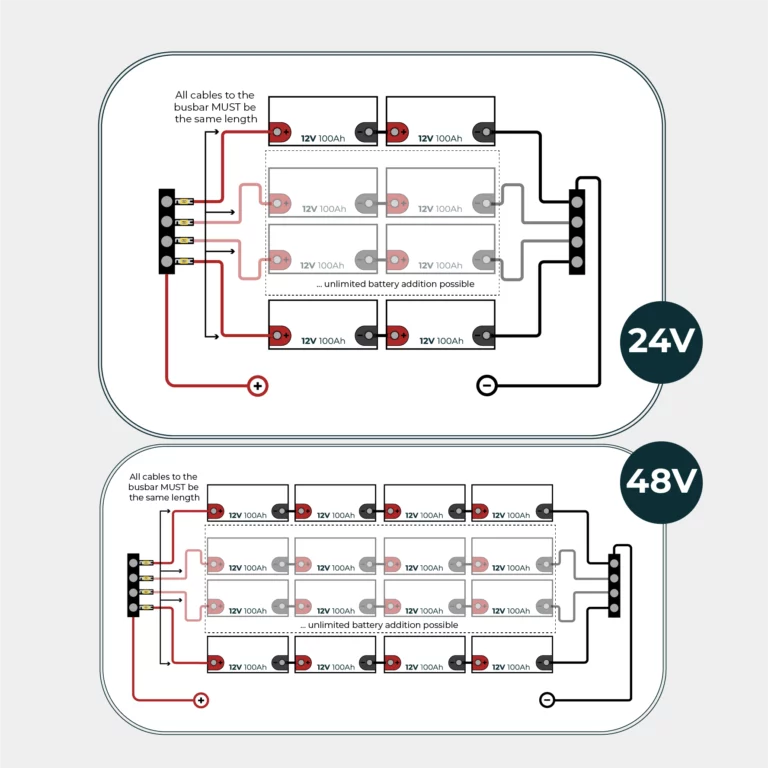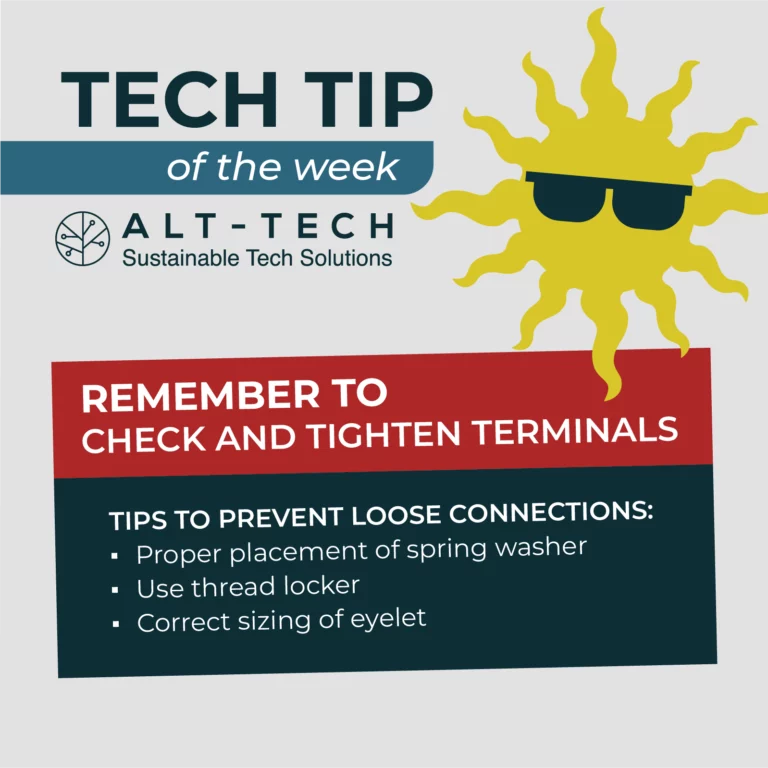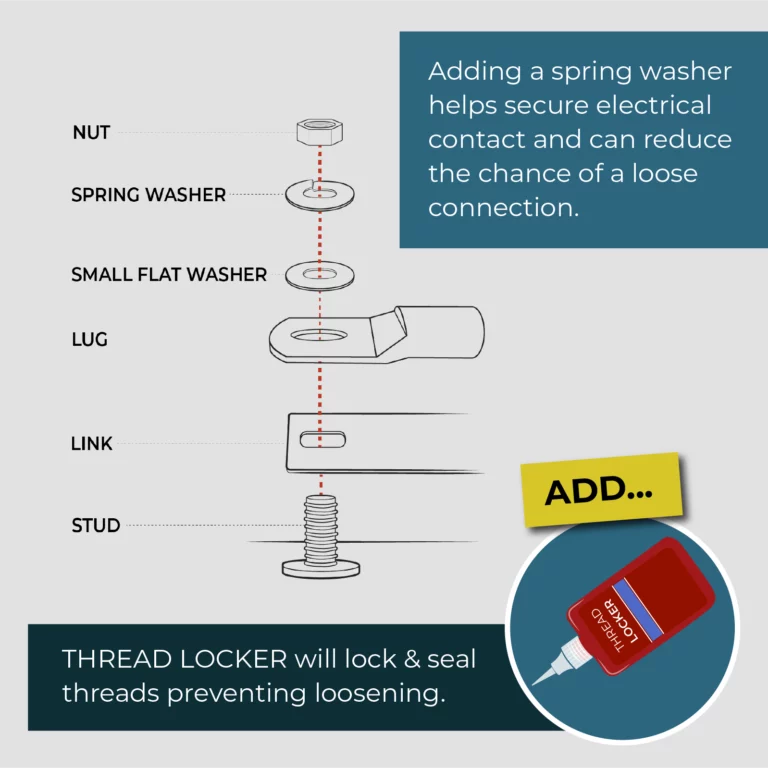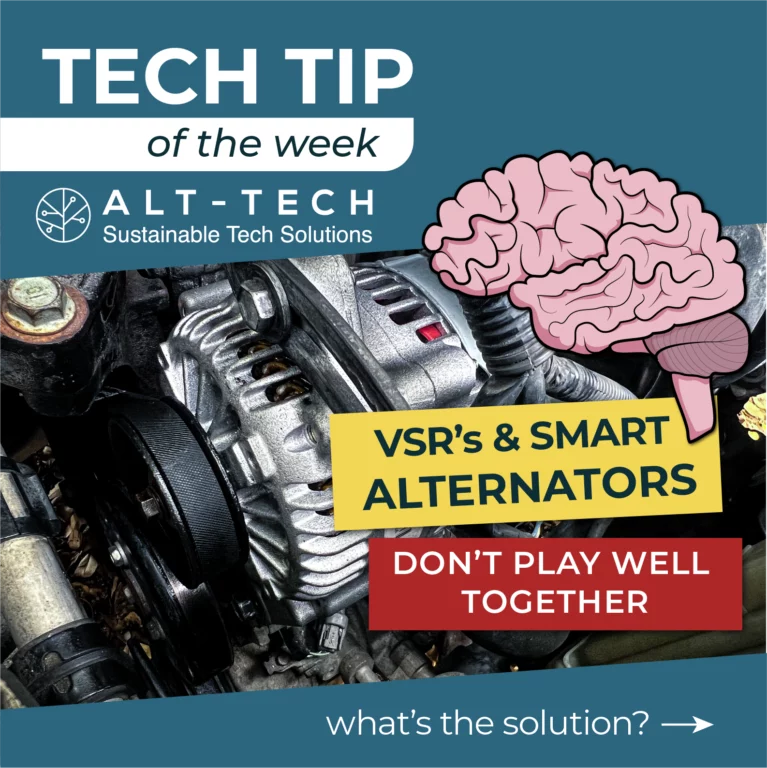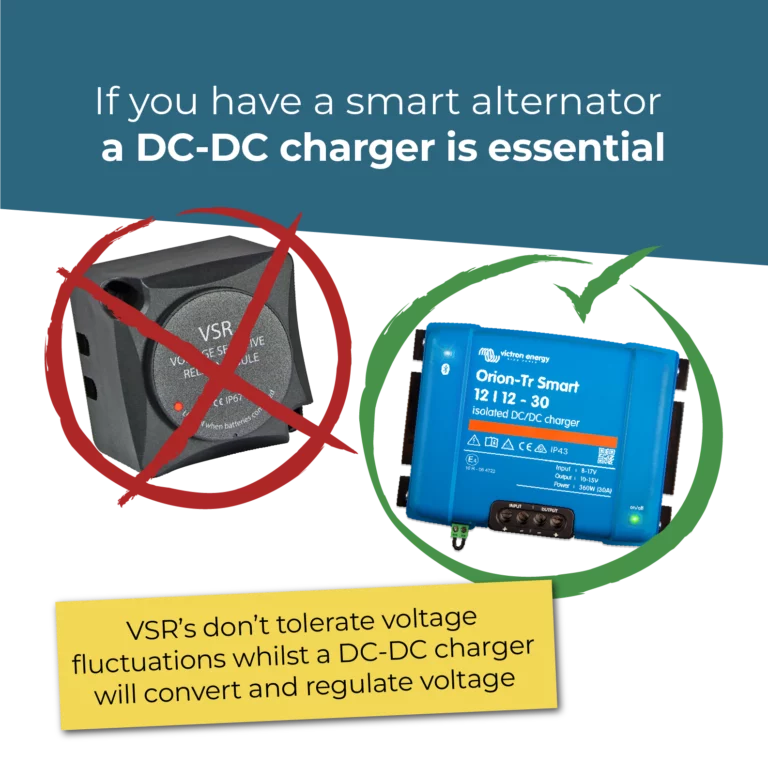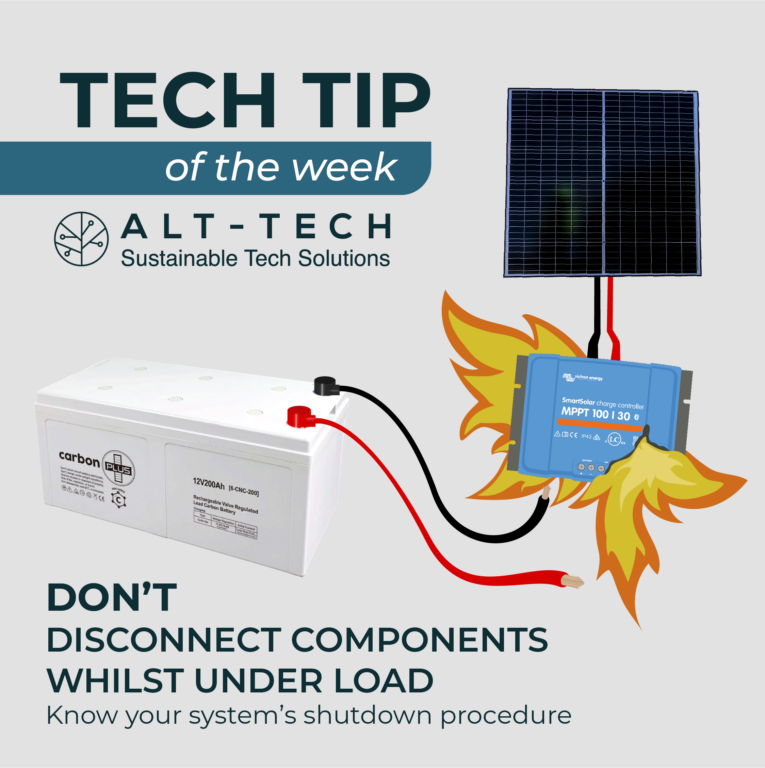Your cart is currently empty!
Tag: Batteries

Parallel VS Series: the battery edition
When configuring a smart shunt or battery monitor, a common mistake we see is people adding up both the amp-hours and the voltage of their battery bank, ending up with a much higher figure for amp-hours than they really have.
Remember:
When batteries are in series, voltage increases whilst amp-hours remains the same.
For example:Four 12v 100Ah batteries in series will result in 48v, 100Ah with 4800wh capacity. When batteries are in parallel amp-hours increase but not voltage.For example: Four 12v 100Ah batteries in parallel will result in 12v, 400Ah giving 4800wh capacity.These battery wiring diagrams help illustrate the difference in parallel and series configurations.
Please be aware: parallel banks require fusing when combining with a distribution system as illustrated in the 24V & 48V diagram.

Check & Tighten your Terminals
As the weather heats up, loose connections can become an issue.
As your copper cabling expands and contracts, once secure terminals can work loose. Even if you’ve done the best job possible during your build, time and temperature fluctuations can wreak havoc.
Follow our tips for the best chance of preventing loose connections, and always check your terminals as the seasons change.
Tips to prevent loose connections:
- Proper placement of spring washer
- Use thread locker
- Correct sizing of eyelet

VSR’s & Smart Alternators
Smart alternators (prevalent in most vehicles made after 2006) provide efficient, variable voltage output, reducing emissions and enhancing battery charging. However, this voltage fluctuation doesn’t work well with traditional charging technology like VSR’s (Voltage Sensitive Relay’s).
The VSR’s depend on a constant voltage higher than 13.3V in most cases to be able to charge the auxiliary battery setup. A smart alternator in junction with the ECU of the car will decide when the starter battery is fully charged after cranking and dial the working voltage down after that, causing the VSR flick open and stoping the charging.If you have a smart alternator a DC-DC charger is essential.
These chargers efficiently convert and regulate their working voltage, ensuring your leisure battery receives the right charge, maintaining power on the road.
Shop DC-DC’s
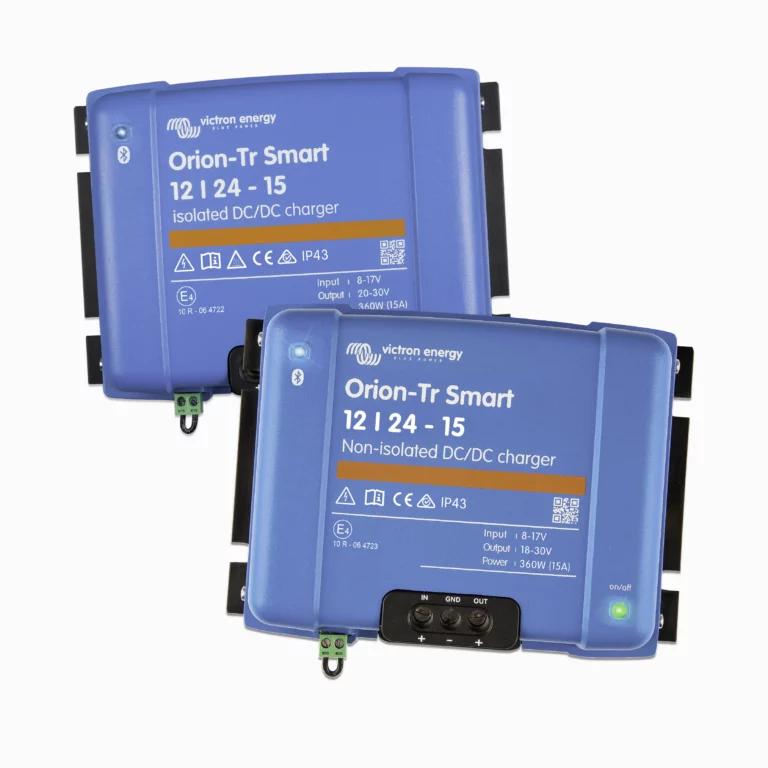
DC to DC
Charge and maintain your batteries with DC to DC charging, our range includes convertors and isolated and non-isolated options from brands such as Victron and Enerdrive suitable for 12v, 24v or 48v.

Standard Lugs VS Narrow Palm Lugs
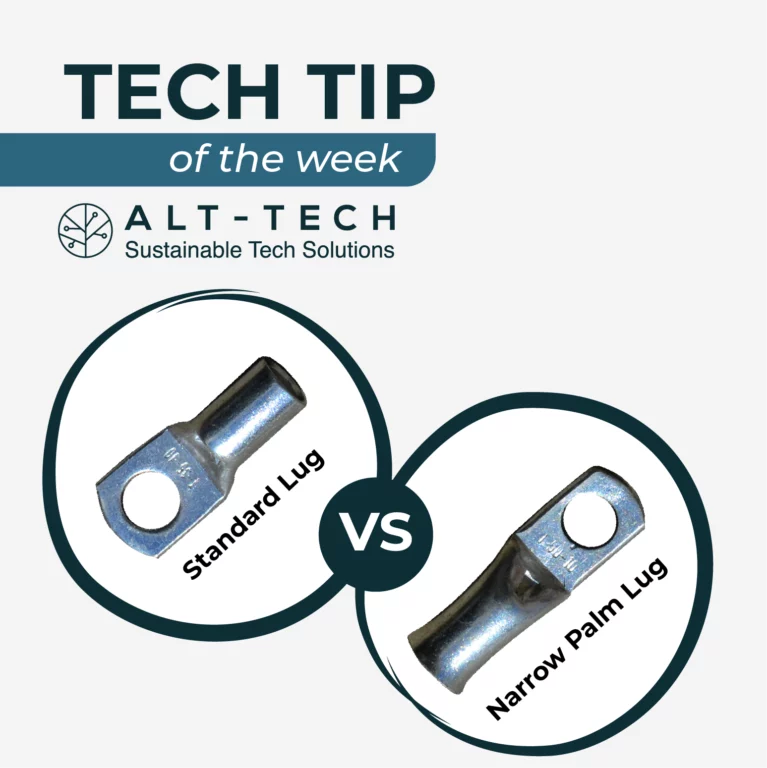
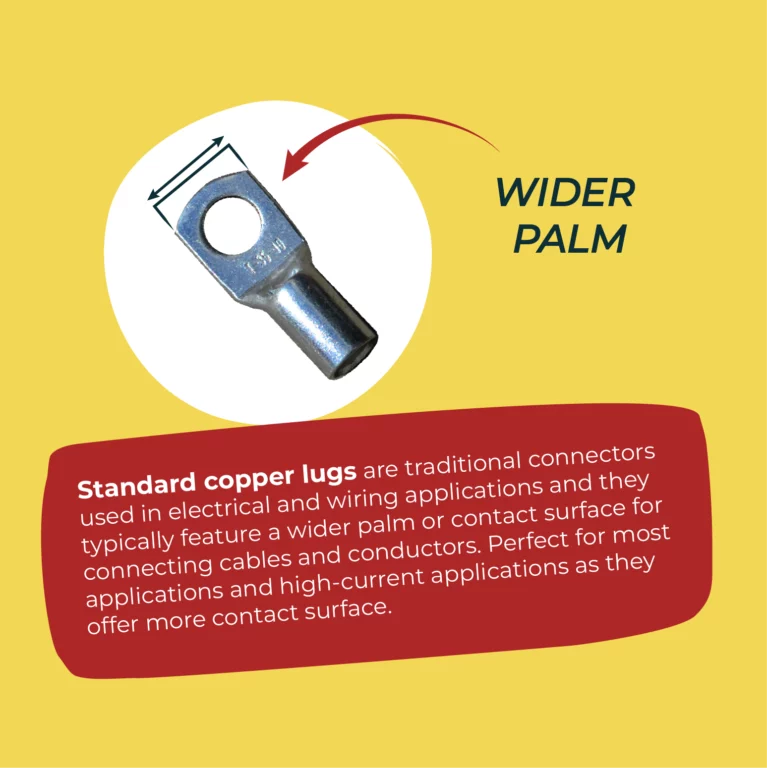

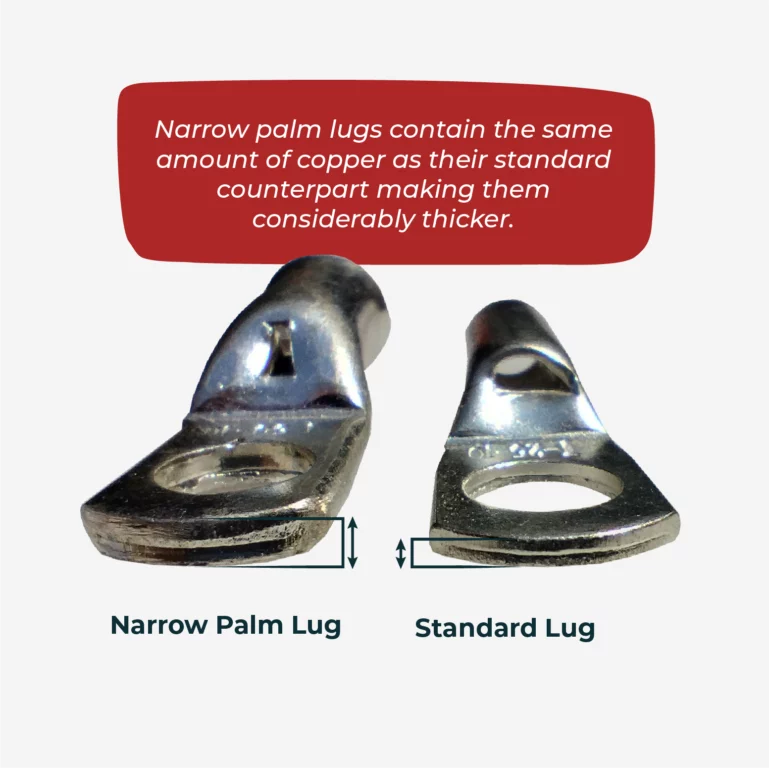
Standard copper lugs are traditional connectors used in electrical and wiring applications; they typically feature a wider palm or contact surface for connecting cables and conductors. Perfect for most applications and high-current applications as they offer more contact surface.
Narrow palm copper lugs are a specialized type of lug connector with a narrower contact surface compared to standard lugs. This design is specifically tailored to certain applications. Awesome for space constrained applications, providing a secure and precise connection maintaining excellent copper conductivity.
When choosing between lugs it’s essential to consider the specific requirements of your project. Standard copper lugs offer versatility and high current-carrying capabilities, making them suitable for a wide range of applications.
On the other hand, narrow palm copper lugs are ideal when space is limited, ensuring a secure and precise fit.
Isolated VS Non-Isolated DC-DC Chargers
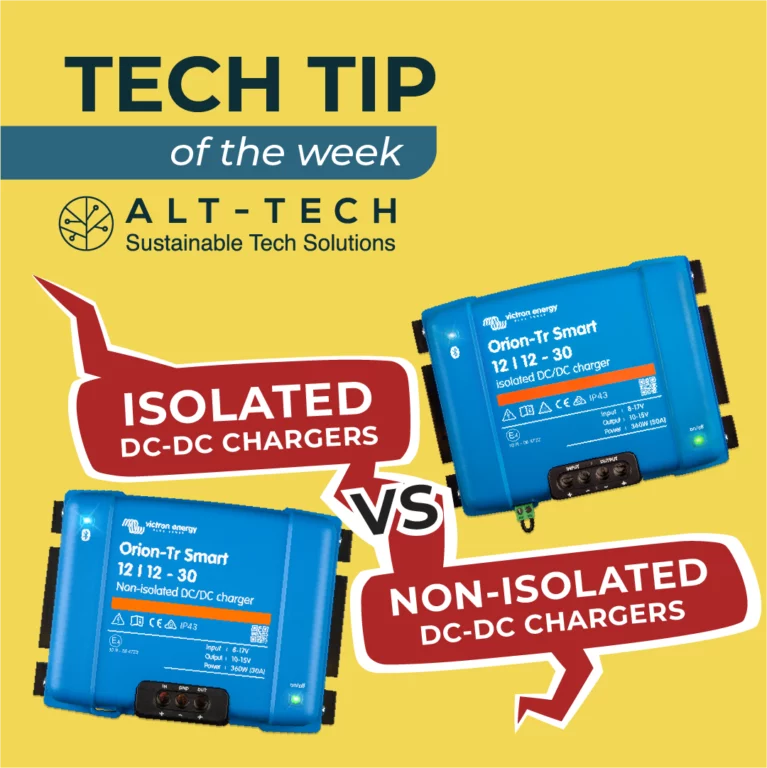
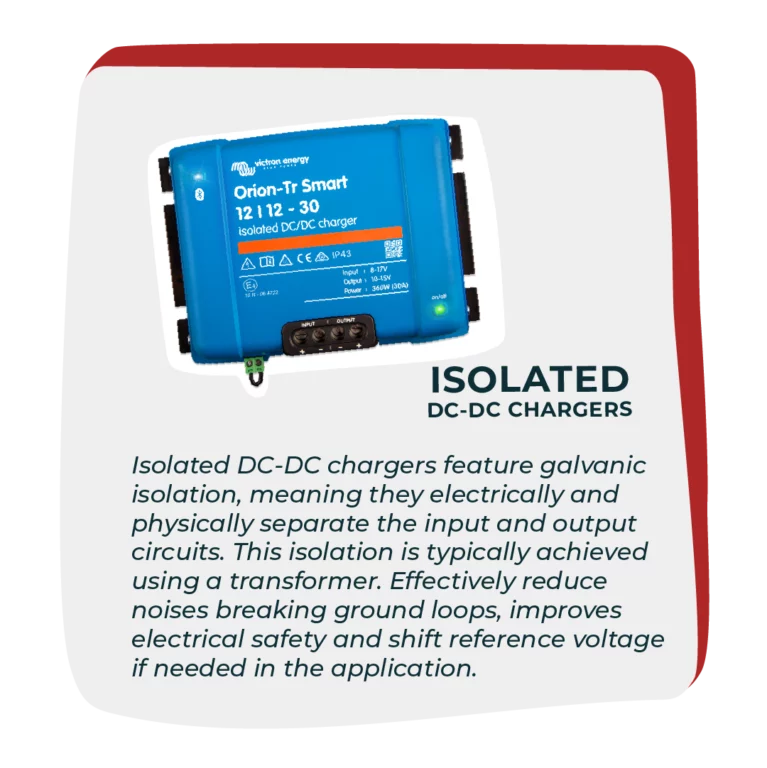
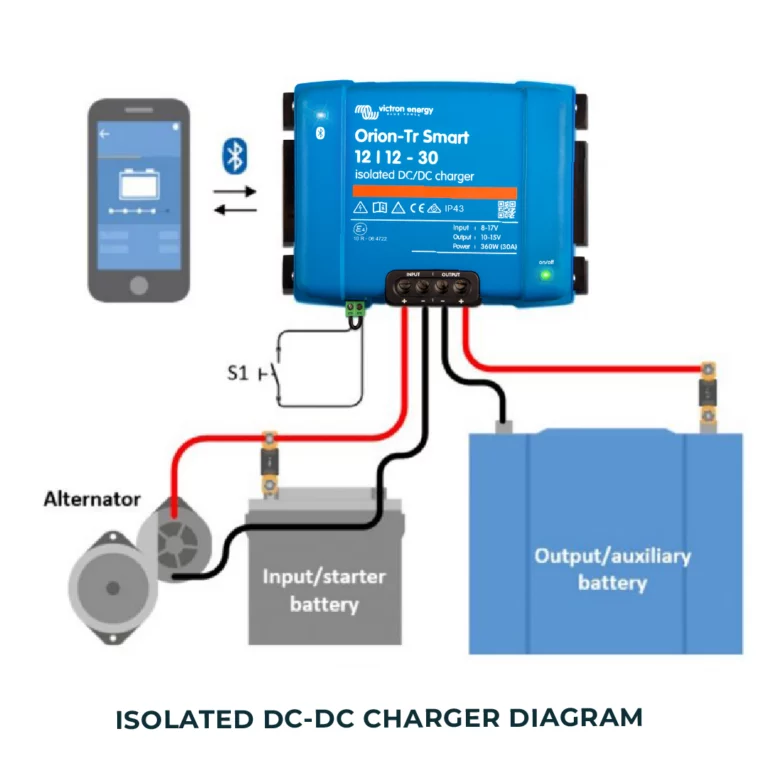
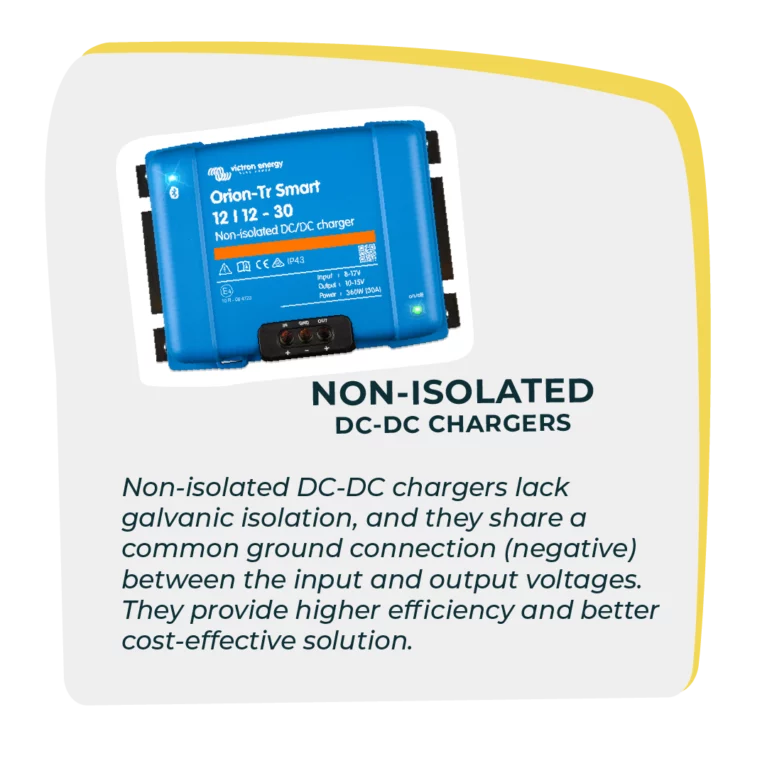
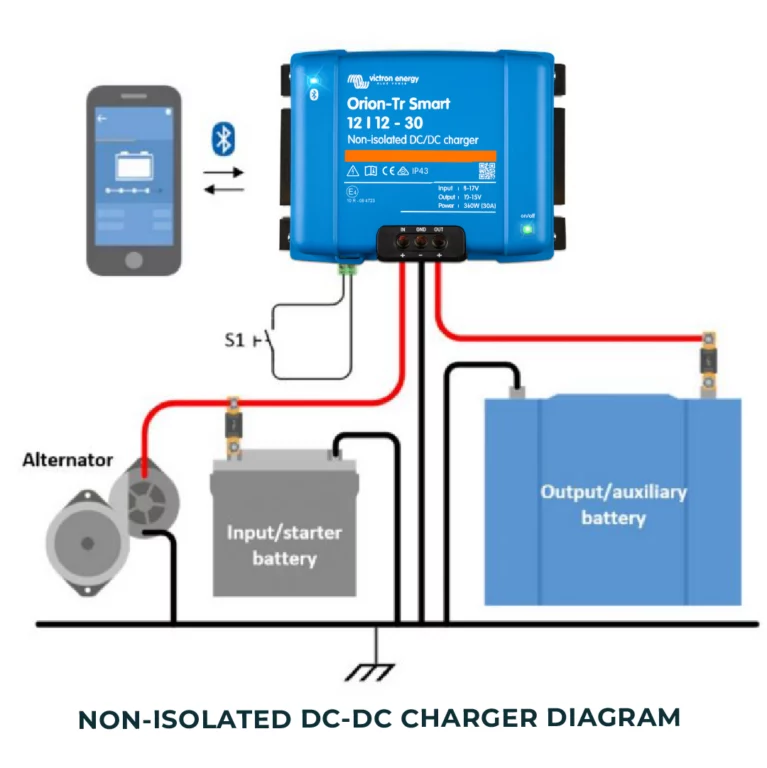
For this weeks Tech Tip we’re comparing isolated and non-isolated chargers, which one meets your needs?
Isolated DC-DC chargers feature galvanic isolation, meaning they electrically and physically separate the input and output circuits. This isolation is typically achieved using a transformer. Effectively reduce noises breaking ground loops, improves electrical safety and shift reference voltage if needed in the application.
Non-isolated DC-DC chargers lack galvanic isolation, and they share a common ground connection (negative) between the input and output voltages. Higher efficiency and are a more cost-effective solution.
How to choose
Choosing between isolated and non-isolated DC-DC chargers depends on your specific project requirements. If safety, ground loop isolation, or reference voltage shifting is critical, isolated chargers are the way to go. On the other hand, if cost savings, space constraints, or energy efficiency are your primary concerns, non-isolated chargers offer a practical solution.Shop DC-DC

DC to DC
Charge and maintain your batteries with DC to DC charging, our range includes convertors and isolated and non-isolated options from brands such as Victron and Enerdrive suitable for 12v, 24v or 48v.

Disconnecting Components
Disconnecting the battery, or any device under load, can cause voltage spikes and fluctuations which may damage the inverter, charge controller, and other sensitive electronics connected to the system, leading to costly repairs, replacements and voided warranty.
To avoid these issues, it’s generally advisable to follow proper shutdown procedures for your off-grid setup, including turning off or disconnecting appliances and systems before disconnecting the battery.

Decoding Battery Technologies: AGM, Lead-Carbon, and LiFePO4 Batteries
In our rapidly evolving world, energy storage is a critical component of various industries, from powering electric vehicles to ensuring uninterrupted energy supply in remote locations. Among the diverse battery technologies available, three noteworthy contenders are Absorbent Glass Mat (AGM) batteries, Lead-Carbon batteries, and Lithium Iron Phosphate (LiFePO4) batteries.
This article delves into the unique characteristics, applications, and advantages of each technology, helping you make informed decisions about which battery type suits your specific needs.
AGM Batteries: A Dependable Classic
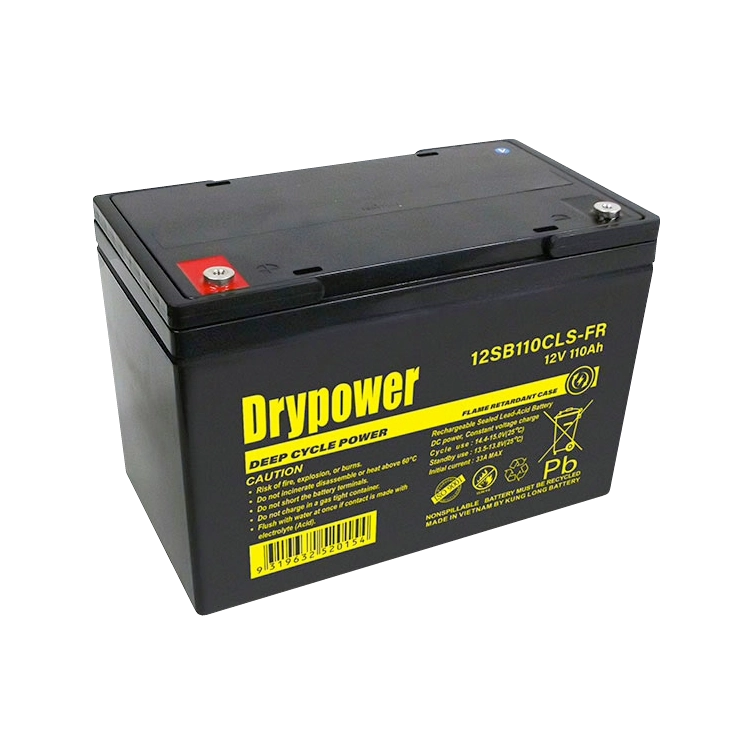
AGM batteries have long been a reliable choice for various applications, from uninterruptible power supplies (UPS) to marine and recreational vehicles. They utilize a glass mat separator, which is saturated with electrolyte to ensure minimal maintenance requirements and a spill-proof design. AGM batteries are known for their:
- Deep Cycling Abilities: AGM batteries can withstand deep discharge cycles without significant performance degradation, making them suitable for applications requiring frequent charging and discharging.
- Vibration Resistance: Their construction offers enhanced durability against vibrations, making them ideal for mobile applications like RVs and boats.
- Maintenance-Free Operation: Sealed design eliminates the need to add water or electrolyte, reducing maintenance efforts.
Lead-Carbon Batteries: Merging Tradition with Innovation
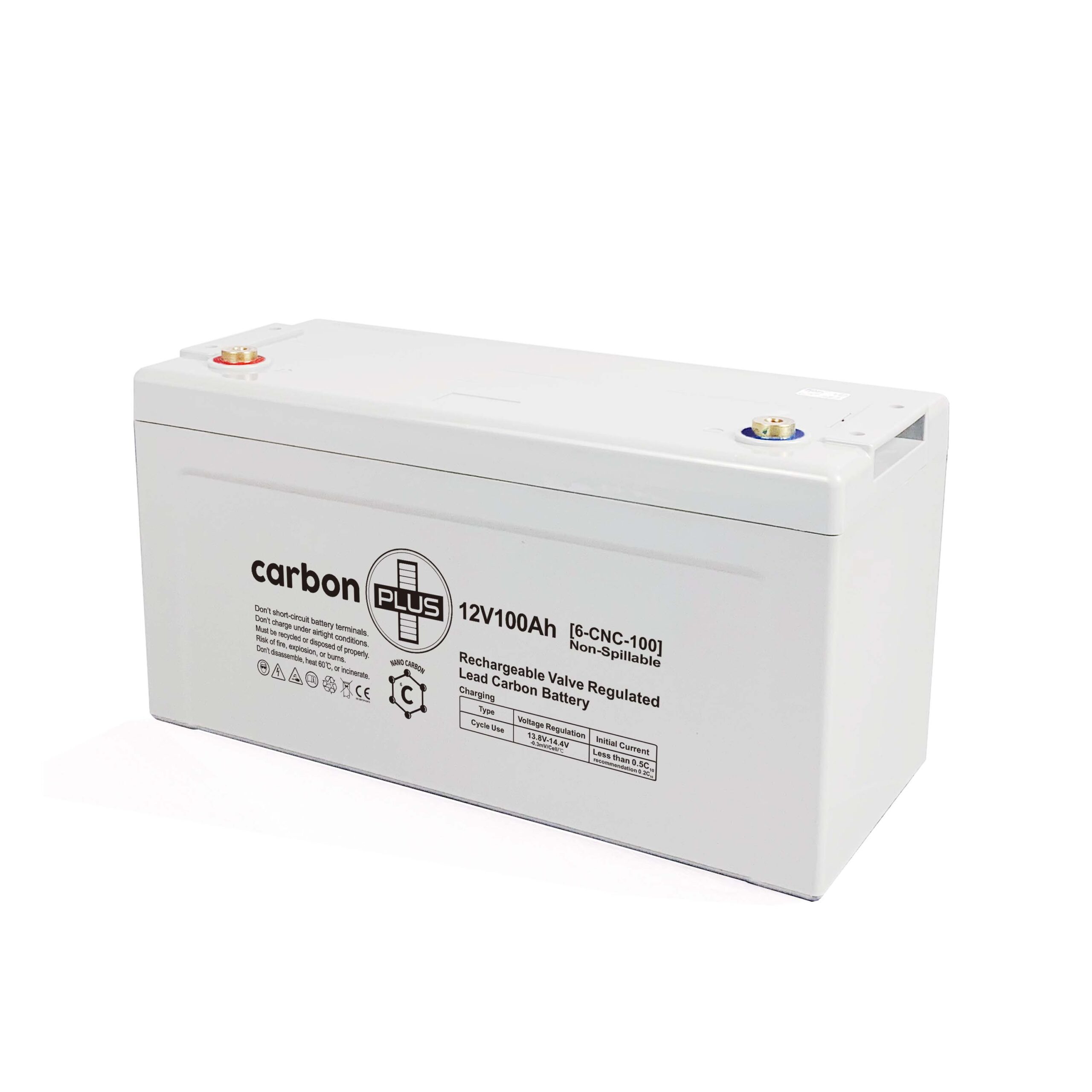
Lead-Carbon batteries combine the strengths of traditional lead-acid batteries with advanced carbon technology. This hybrid approach brings several advantages, making them a preferred choice for applications such as renewable energy storage and telecom backup systems. Key features of Lead-Carbon batteries include:
- Enhanced Cycle Life: Incorporating carbon technology extends battery life and improves cycle performance compared to standard lead-acid batteries.
- Fast Charging: Lead-Carbon batteries can accept higher charging currents, reducing the time required for recharging.
- Partial State of Charge Tolerance: Lead-Carbon batteries can operate efficiently even at partial states of charge, minimizing the risk of sulfation.
LiFePO4 Batteries: Pioneering Energy Density and Longevity
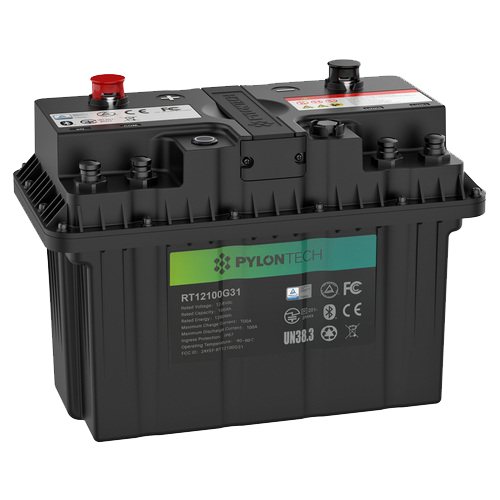
Lithium Iron Phosphate (LiFePO4) batteries have taken the energy storage market by storm, offering high energy density, exceptional cycle life, and lightweight construction. These batteries have become the go-to choice for electric vehicles, renewable energy systems, and portable electronics. Key advantages of LiFePO4 batteries include:
- High Energy Density: LiFePO4 batteries offer a high energy-to-weight ratio, allowing for more compact and lightweight designs.
- Extended Cycle Life: With thousands of charge-discharge cycles, LiFePO4 batteries outlast many other battery types, contributing to lower long-term costs.
- Safety: LiFePO4 chemistry is inherently stable, reducing the risk of thermal runaway and fire incidents associated with some other lithium-ion chemistries.

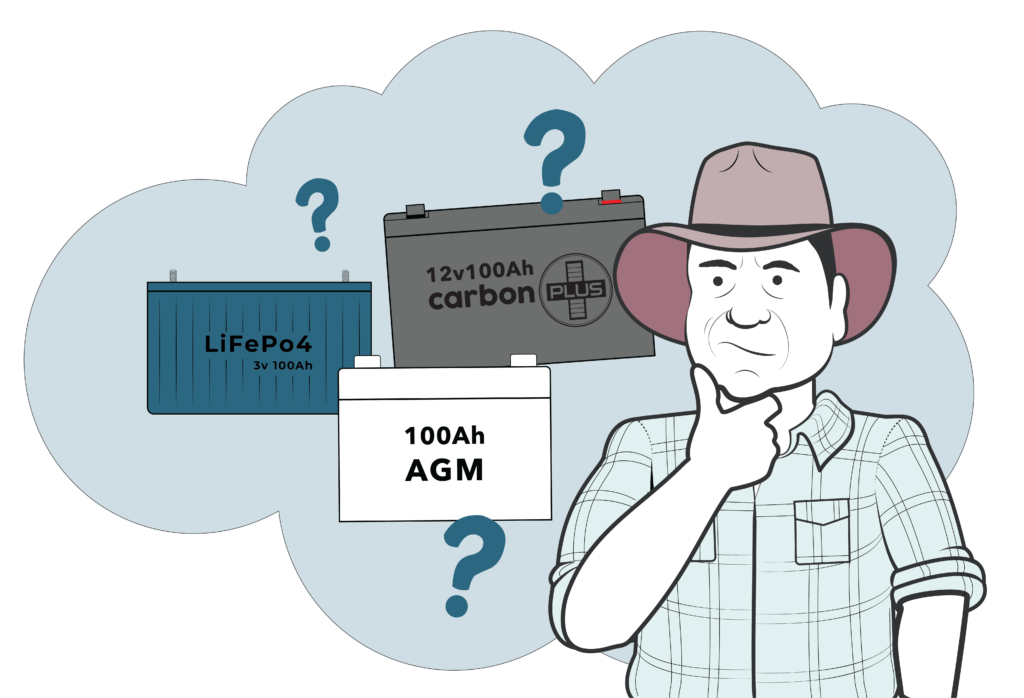
Choosing the Right Battery for Your Needs: Use Cases, Pros and Cons

AGM
Use Cases
- Recreational Vehicles: Their durability and resistance to vibrations make them suitable for powering RVs and boats.
- Backup Power: AGM batteries serve as backup power sources for critical systems like data centers and medical equipment.
Pros
- Maintenance-Free: Sealed design eliminates the need for regular maintenance and water additions.
- Deep Cycling: AGM batteries handle deep discharge cycles well, making them suitable for applications requiring frequent cycling.
- Vibration Resistance: Ideal for mobile applications due to their ability to withstand vibrations.
Cons
- Limited Energy Density: AGM batteries have lower energy density compared to some other technologies.
- Sensitive to Overcharging: Overcharging can lead to reduced battery life and potential damage.

Lead-Carbon
Use Cases
- Renewable Energy Storage: Lead-Carbon batteries are used to store energy generated by solar panels and wind turbines.
- Telecom Backup: Their fast charging and partial state of charge tolerance make them valuable for backup power in telecom systems.
Pros
- Enhanced Cycle Life: Combining lead-acid and carbon technology results in longer battery life and improved cycle performance.
- Fast Charging: Lead-Carbon batteries accept high charging currents, reducing downtime.
- Partial State of Charge Tolerance: Can operate efficiently even at partial charge levels.
Cons
- Moderate Energy Density: Lead-Carbon batteries have lower energy density compared to lithium-ion technologies.
- Weight: They tend to be heavier than some other battery types.

LiFePO4
Use Cases
- Electric Vehicles: LiFePO4 batteries power electric cars due to their high energy density and long cycle life.
- Renewable Energy Systems: They store energy from solar and wind sources for later use.
- Portable Electronics: LiFePO4 batteries are used in laptops, smartphones, and other portable devices.
Pros
- High Energy Density: LiFePO4 batteries offer excellent energy-to-weight ratio.
- Long Cycle Life: Thousands of charge-discharge cycles before significant capacity degradation.
- Safety: Stable chemistry reduces the risk of thermal runaway and fire incidents.
Cons
- Higher Cost: LiFePO4 batteries can be more expensive upfront compared to other battery types.
- Limited Voltage Range: Voltage per cell is lower than some other lithium-ion technologies, requiring more cells for certain applications.
Tailoring Your Choice to Your Needs
Selecting the appropriate battery technology involves understanding the unique benefits and limitations of AGM, Lead-Carbon, and LiFePO4 batteries. AGM batteries offer reliability and deep cycling for applications requiring constant charge-discharge cycles. Lead-Carbon batteries blend tradition with innovation, excelling in renewable energy storage and backup power scenarios. LiFePO4 batteries lead in energy density and longevity, making them ideal for electric vehicles and energy-intensive applications. By assessing your specific requirements against these technologies’ strengths and weaknesses, you can make an informed decision that aligns with your goals for efficiency, reliability, and sustainability.
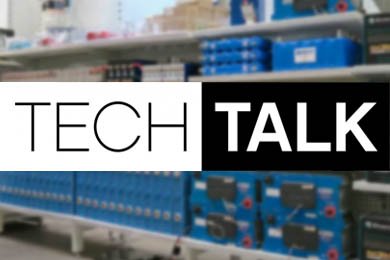
Lithium Batteries: Wiring a BMS
A lithium phosphate battery cell is 3.2V nominal (between 2.65 – 3.65V). This is the limit of the cell’s chemistry, so if we want more than 3.2V, we need to put the cells in series. (Translation for people with a social life – connect the positive terminal of one cell to the negative terminal of the next)
2 cells gives you 3.2 + 3.2 = 6.4V, 4 cells gives you 12.8V, 8 cells gives you 25.6V etc.
So if you want a 12V battery (nominal), you put 4 cells in series and charge them up. Simple, right?
That’s how it works with many batteries, but lithium cells tend to become unbalanced. If you put 4 in series and charge the whole pack to 14.2V (3.55V / cell, at which point the battery is fully charged although the cells can technically go a little higher), the charge becomes unevenly distributed. After a few cycles, one cell will reach 3.8V or higher and die.
Enter the BMS, or ‘Battery Management System’. The purpose of a BMS is to balance the cells, and turn off the battery if one cell gets too high or low, so the whole battery doesn’t fail. All BMS systems have cell monitoring and protection, and most have cell balancing incorporated, although some require separate balancing. (note – some BMS’s on the market incorporate a charging system as well. We will be focusing solely on the protection / balancing aspect)
A BMS must monitor the voltage of each cell and be able to shuffle power around in order to keep them at the same level of charge. To do this, a lead is run to each cell. In a 12V system, you will have one wire going to the negative point of the bank, and a wire going to the positive of each cell. The BMS monitors each cell relative to that first negative, so it expects to see 3.2V from the first to the second lead, then 6.4V from the first to the third, etc. For that reason it is very important to get your leads in the correct order (if you don’t your BMS will go pop) – Hint: Use a multimeter to check the voltage at the pins of the plug before you plug in to the BMS.
A BMS must also provide protection. Most BMS boards have the protection incorporated – they will have a copper plate where the output cable can be soldered or bolted to the device itself. One side goes to the battery, the other to your load. If any one cell gets to high or too low, the BMS cuts out to protect the battery bank. Some BMS systems rely on a system of relays in stead, but we will cover the types of BMS more in depth later.
Whilst most BMS systems have cell balancing incorporated, it is generally passive or resistive balancing. It only works in the top 15 – 20% of the charging cycle, and they tend to get hot. With larger cells, or with a battery bank that is working hard, passive balancing may not keep up, causing the BMS to trip more often or the bank to operate at a lower capacity. Active balancing that uses capacitors and operates through the entire charging cycle produces less heat is advisable – by keeping the cells at an even voltage, it ensures each cell gets a full charge with every cycle which improves both the efficiency and the cycle life of the battery.
Further reading

DC Ripple and Batteries
DC Voltage is usually thought of as constant – You have a 12V battery, it outputs a steady Voltage, only changing gradually as it is charged and discharged.
DC ripple occurs when the Voltage of a DC system oscillates, usually only on a scale of milivolts. It can happen for a number of reasons.
- Volt droop – As you discharge a battery, the Voltage drops. Volt droop refers to the phenomenon by which the voltage drops disproportionately low under a heavier load. Say if you discharge a 12V battery from 13V down to 12V. If the load was heavy for the battery’s size and you turn it off once the battery reaches 12V, you will see the voltage come back up – maybe to 12.1, maybe to 12.5 – depending on how heavy the load is. This is not DC ripple on it’s own, but DC ripple occurs due to Voltage droop when loads are uneven – and most loads are. A 240V battery inverter will pull more power at certain points in the wave, which causes the battery Voltage to oscillate at a rate of 50Hz – too quickly to show up on a multimeter, but can be observed on an oscilloscope.
- Charging methods – Most methods of charging a battery do not provide a truly constant voltage to the battery. On the extreme end you have switch mode power supplies and PWM solar controllers which let through high Voltage pulses. Even high quality charging equipment tends to allow small ripples and smart chargers use high Voltage pulses to sense battery Voltage (still go for a 3 – stage charger if you can – the benefits far outweigh the small disadvantage).
- Rapid charge – discharge cycles. So you’re charging your batteries from solar at the same time as you’re using them. Output power isn’t constant, neither is input power, and the load includes an inverter. You have DC ripple due to the inverter power, an uneven draw, and uneven input power all at once.
So why does this matter?
Firstly, at high enough voltages, DC ripple carries similar risks to AC current. This isn’t worth worrying about with a simple 12 or 24 Volt system, but at higher Voltages it is something that professionals need to be aware of. Battery life – DC ripple basically charges and discharges your battery very fast. Whilst only at the scale of mili – or – micro – volts, these mini – cycles do add up and long term shorten the usable life of your battery. How much will depend on the type of battery and the severity of the DC ripple. Batteries with a higher internal resistance experience a greater degree of DC ripple – So lead batteries typically fare worse than lithium batteries of the same size. On the flip side, the high voltage spikes put out by PWM controllers and other cheap chargers are especially damaging to lithium batteries.
What can be done to minimize DC ripple?
- Quality charging – Avoid PWM’s if possible and go for an MPPT, use quality 240V chargers as well if possible.
- Ensure your battery bank is properly sized. Lead batteries shouldn’t be discharged faster than 0.2C, or 20% of the batteries Amp – hour capacity, i.e. if you have a 100Ah battery, you shouldn’t pull more than 20Amps from it. Lithium and lead – Carbon batteries can be discharged faster, so go for these if running heavy loads.
- You knew I was going to talk about supercapacitors. These have a much lower internal resistance than either lead or lithium batteries, and have millions of charge – discharge cycles in stead of mere thousands. With a supercapacitor in parallel with a battery bank, all of those micro – cycles go through the supercapacitor first, buffering or eliminating the DC ripple effect. This is not necessarily a cost effective solution for a small AGM battery, but on larger banks it’s a no–brainer.

What’s the Safest Battery?
The most common batteries used today in small to household – sized setups fall into two categories – Lead acid and Lithium.
Lead
Lead batteries fall into several different categories;
Flooded
Flooded lead batteries are commonly used for cranking (the battery under your bonnet is almost certainly a flooded lead – acid). They contain a liquid Sulfuric Acid electrolyte. Every time the battery is charged or discharged, some of this electrolyte degrades to form hydrogen sulfide gas, which is flammable. Flooded lead batteries can produce enough hydrogen sulfide to build up and explode, so large installations require a specialised ventillation system. Flooded lead batteries can also be spilled; The electrolyte can produce dangerous / flammable fumes depending on what it comes into contact with.
AGM / Gel
AGM and Gel batteries are different but in terms of safety they fall into the same category – Non spillable, valve regulated lead acid.AGM’s immobilise the sulfuric acid electrolyte in a special absorbent glass mat, which reduces the hydrogen sulfide produced. Gel batteries, similarly, contain a sulfuric acid electrolyte that is mixed with a gelling agent. Both of these batteries are recommended to ‘not be charged in a gas tight container’ but are safe to have in an enclosed space such as a vehicle or a building. Lead – Carbon batteries generally are also either AGM or Gel batteries in terms of electrolyte, but because of their better charge / discharge efficiency and their slightly lower operating Voltage, Hydrogen Sulfide production is even lower.
Lithiuim
There are two broad categories of lithium batteries. Lithium – Ion is the general term used for lithium – Cobalt, lithium – manganese and a few other varieties. LFP, LiFePO4, lithium – Iron (not ion), or LiFePO is the term used for Lithium Ferrous Phosphate batteries.
Lithium ion batteries have advantages in weight and charge / discharge ratings but if mismanaged present a serious fire hazard as they contain a flammable electrolyte that bacomes explosive on contact with water.
LFP batteries are comparitively very safe. They handle the heat better and last longer, but are slightly heavier. Whilst the electrolyte is technically still flammable under extreme conditions, fires starting from LFP batteries are exceedingly rare and typically only occur when a high voltage bank gets short circuited, or when battery cells are mechanically damaged and then get wet. Prismatic LFP cells are some of the safest batteries available.
Fusing
Regardless of chemistry, batteries store a lot of energy and an electrical fault caused by a short circuit or an undersized conductor can start a fire simply because of the heat produced by the current. It is essential to ensure that all cables and links are correctly sized. Anything directly connected to a battery should be fused. Single – pole fuses and isolators, by convention, go on the positive terminal of your battery, and with good reason – In a vehicle, the starter battery is earthed to the chassis, i.e. the entire body of the car is negative. This means that if your positive cable comes into contact with the body of the vehicle at any point, it can create a short circuit (in layperson’s terms, this will cause electrical current to be drawn from the battery extremely fast, producing heat, which could case a fire). Fusing any cable going to the positive terminal of a battery, as close to that terminal as possible, is therefore an essential safety measure.
In higher Voltage / stationary systems, a ‘double – pole’ fuse or magnetic circuit breaker is used and generally double – sheath cable or conduit is used between the battery and the breaker. There are strict standards on the protection equipment that can be used and installation layout for larger systems.
Edit: Since this Tech Talk was written we have now added Lead-Carbon to our range. You can read about this technology here:

